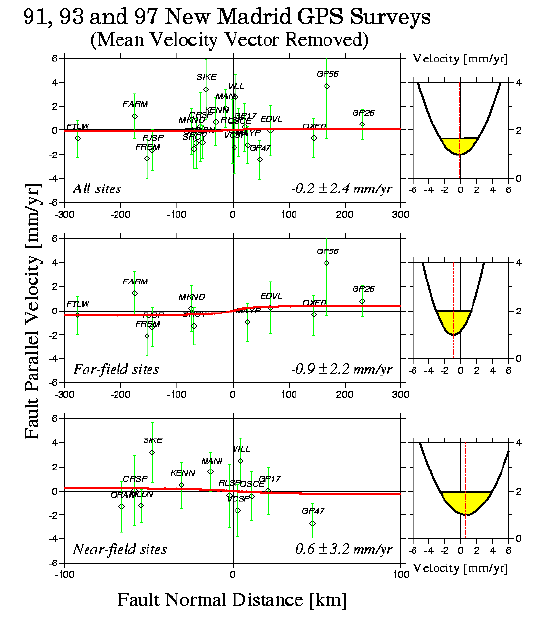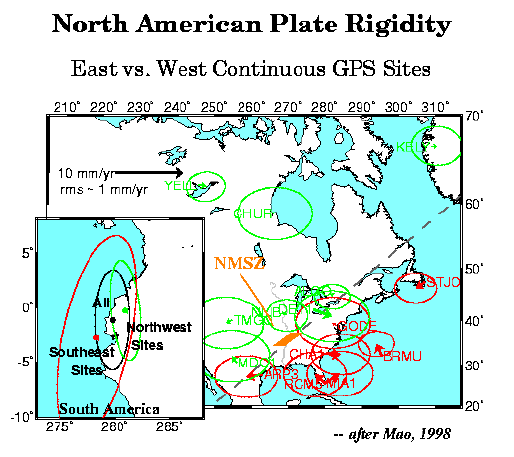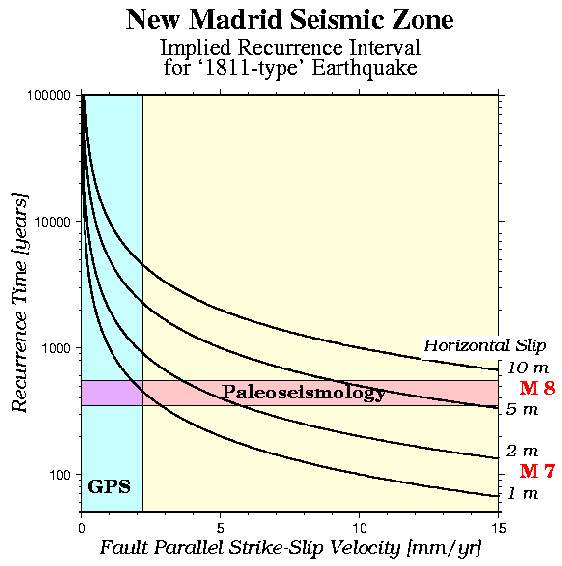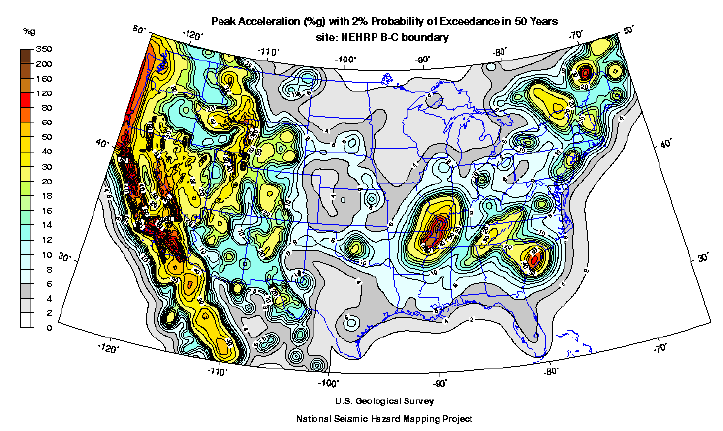Determining tectonic motion across the New Madrid Seismic Zone
Andrew V. Newman
|
|
On a project with Seth Stein, John Weber (Grand Valley State),
Joe Engeln (Missouri), Tim Dixon and Ailin Mao (both at Univ. of Miami), I
am working to determine the velocities of plate motion across the New Madrid
Seismic Zone. We are achieving this by doing intermitant GPS (Global
Position System) surveys across the region. So far, sites have been
measured three times (1991,93,97). We hope that with these data, we can
determine whether there is significant differential motion, especially
between the near and far fields. This work is instrumental in determining
the recurrence rate of large earthquakes (s.a. the 3 assumed magnitude 8's
in 1811-12) in the region.
|
|
The below figures are the results from the three recent GPS
surveys performed by Northwestern. The results are quite surprising.
|

*click on illustration for a larger view
|
This is a map view of the New Madrid Seismic Zone and surrounding areas. The fault
zone (yellow) is located in the upper middle of the diagram. The red arrows
show the annual motion of each site with respect to the ITRF96 North American
Plate motion.
|

*click on illustration for a larger view
|
Left panels: Profiles of site velocities, with 1-sigma error bars, parallel to the
approximate strike direction of the major right-lateral strike-slip faults in the
NMSZ. Panels show the entire network and its far- and near- field subsets. For each,
the profile mean is removed. Also shown are best-fitting profiles computed
for a locked vertical strike-slip fault driven by far-field motions. Misfit as a function
of far-field velocity is shown on the right, with 2 sigma range colored yellow.
None of the best fitting velocities differ significantly from zero.
It is very interesting that motion across the fault is indistinguishable from zero,
within errors. This signifies that if the current motions are representative of
long-term dynamics, then the recurrence time for a magnitude 8 earthquake
(assumed magnitude of 1811-2 series, with 5-10 meters of slip), is greater than
3,000 years!
|

*click on illustration for a larger view
|
Locations of continuously recording GPS sites used to estimate an Euler vector
for the presumably-stable portion of North America. For each, the misfit between
the observed velocity and that predicted for a single plate is shown. These misfits
have a mean of 1 mm/yr.
Inset: Euler poles for the eastern and western subsets of the sites (divided by
dashed line) compared to that for the entire set. Because the poles for the east
and west data overlap at 95% confidence, the platewide GPS data show no resolvable
motion across the NMSZ.
|

*click on illustration for a larger view
| Relation between inter-seismic motion and the recurrence time of large New Madrid
earthquakes. For an assumed horizontal slip in 1811-1812 of 5-10 m, the geodetically
observed inter-seismic motion of less than 2 mm/yr discussed here implies recurrence
times greater than 2500 yr. Also shown are recurrence estimates from paleoseismic
studies. The paleoseismic and geodetic data are jointly consistent with slip in
1811-1812 being about 1m, corresponding to a magnitude 7 earthquake.
|

*click on illustration for a larger view
|
Top: Earthquake frequency-magnitude data for the New Madrid zone. Both the recent
and historic (1816-1984) data have slopes close to one, and predict a recurrence
interval exceeding 1,000 yr for magnitude 7 earthquakes and 10,000 yr for magnitude
8 earthquakes.
Bottom: Earthquake history for the NMSZ. Since 1816, there have been 16 earthquakes
with magnitude greater than 5 (about a 10-yr recurrence), and two with magnitude
greater than 6 (about an 100-yr recurrence). We thus expect magnitude 7 and 8
earthquakes to have about 1,000 and 10,000 yr recurrence.
|

*click on illustration for a larger view
|
National Seismic Hazard map showing predicted peak ground acceleration expected
in 50 yrs at 2% probability [Frankel et al., U.S.G.S. OFR 96-532]. Because these
maps incorporate assumptions of rapid deformation and frequent great earthquakes,
the predicted acceleration for the New Madrid zone exceeds that in San Francisco,
and the predicted very high acceleration (exceeding 1.2g) area for the NMSZ is
larger than for Los Angeles or San Francisco. Our results imply that the seismic
hazard for the New Madrid area is lower and that such maps should be revised.
|
References:
- Newman, A. V., S. Stein, J. C. Weber, J. F. Engeln, A. Mao
& T. H. Dixon, Slow Deformation and Implied Long Earthquake
Recurrence Intervals From GPS Surveys Across the New Madrid
Seismic Zone, Science, 284, 23 April 1999
(
PDF version
)
- Newman, A. V., J. Schneider J., S. Stein & A. Mendez,
Uncertainties in New Madrid Seismic Zone Seismic Hazard,
Seism. Res. Lett., 72 6, 653-667, 2001
- Stein, S., J. Tomesello & A. Newman, Should Memphis Build for California's Earthquakes?
EOS, Trans. Am. Geoph. Union (EOS), 84 19, 17, 2003.
Download PDF version
- Stein, & A. Newman, Characteristic, Uncharacteristic, and Absent Earthquakes as Possible Artifacts of Short
Earthquake Histories, Seismo. Res. Lett. 75, 2, 173-187, 2004.
Download PDF version
|
|
|
Current Research |
Curriculum Vitae |
Sites of interest |
Home
anewman gatech.edu | Updated:
Sun Nov 5 13:52:14 EST 2006 gatech.edu | Updated:
Sun Nov 5 13:52:14 EST 2006
|
 gatech.edu | Updated:
Sun Nov 5 13:52:14 EST 2006
gatech.edu | Updated:
Sun Nov 5 13:52:14 EST 2006
 gatech.edu | Updated:
Sun Nov 5 13:52:14 EST 2006
gatech.edu | Updated:
Sun Nov 5 13:52:14 EST 2006